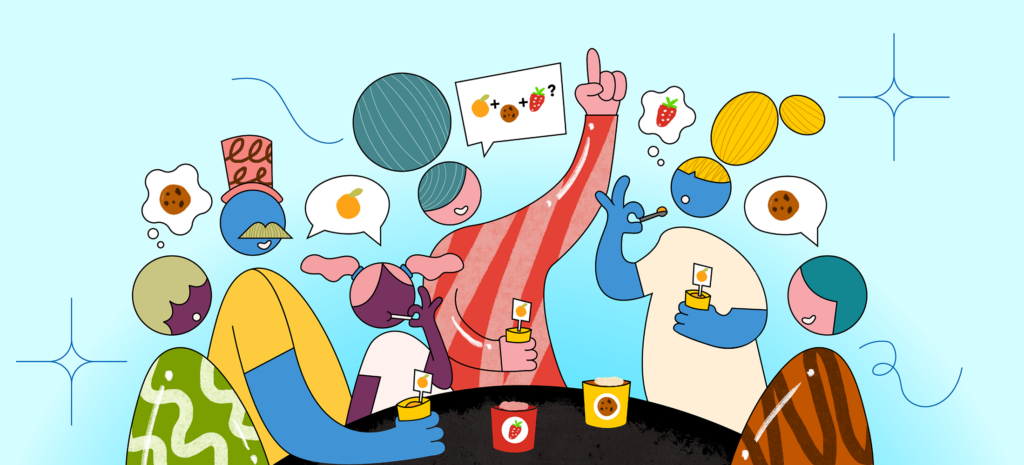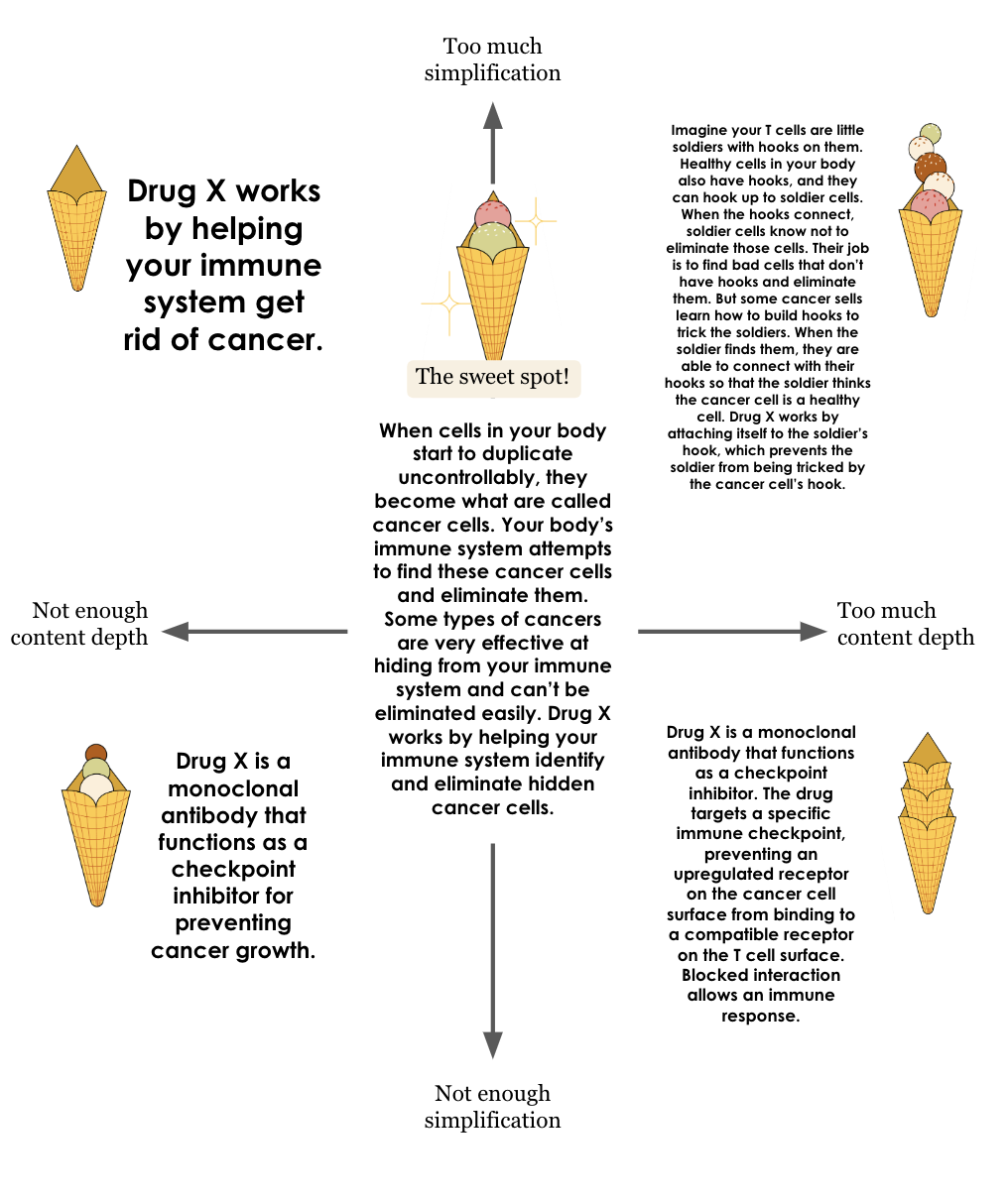
Ideas by Bridgeable
Finding the “simplification sweet spot” in patient communications
Author
- Bridgeable
Differentiating pharmaceuticals in an increasingly competitive market
Imagine the following scenario. Two drug manufacturers are late to market with competing drug launches. Differentiation is the main challenge. The first company employs a differentiation communication strategy that focuses on creating brand awareness by presenting catchy taglines and aesthetically pleasing visuals of happy people. Their campaign is short on educational content, which is relegated to a text-heavy side page on its website. The second company employs a different communication strategy, investing time and money into creating educational content intended to help potential customers better understand their disease and treatment options.
Jonathan has recently been diagnosed with the disease in question. Overwhelmed at the time of diagnosis, he delays making a treatment decision. He goes online to learn more about his condition and comes across the websites for both drugs. Jonathan spends little time on the first company’s website, as it does not provide him with much useful information. He next finds himself on the second company’s website, where he comes across detailed educational information. Pleasantly surprised to see a drug manufacturer put so much effort into creating helpful content, Jonathan spends a great deal of time on the website, referring family and friends to it to help them understand his newly diagnosed condition.
Later, Jonathan discusses treatment options with his doctor, who pulls out the brochure for the second company’s medication. She uses it to explain more about Jonathan’s condition and how treatment works. (She threw away the first company’s brochure after quickly skimming through it and finding little useful information.) Because the available medications cannot be differentiated through data, the doctor ends up recommending what is top of mind. In this case, what is top of mind is the second company’s medication, as she frequently uses its brochure as an educational tool. Jonathan, having already become familiar with the drug manufacturer and having been impressed by their patient centricity, confidently agrees.
Avoiding over-complexity and oversimplification to create patient-friendly communications
In pharma’s post-blockbuster era, the above scenario is becoming commonplace. Patient centricity is critical to market differentiation, yet too many companies still consider well-crafted, in-depth, accessible educational content to be an afterthought. The result of this is that what should be strategically valuable educational content on pharma websites and in brochures ends up serving little purpose but to take up valuable real estate. This is because most pharmaceutical educational content suffers from one of two major problems: It is either overly complex or oversimplified. Either extreme has the potential to significantly undermine a drug communication strategy, leading to customer alienation, failure to achieve desired customer behavior, wasted company resources and time, failure to differentiate, and a drug that underperforms in a competitive market. Avoiding these extremes and aligning on a strategy to differentiate through education requires an up-front investment of time and resources into building a patient-centric communication capability.
The backbone of such a capability is the development of a critical eye. This will enable you to identify the different communication traps that you can fall into and carefully navigate away from them.
The four simplification traps
At its core, simplifying complex information involves converting expert concepts into a form that a non-expert can understand. The problem is that many simplification efforts end up creating content that is overly complex or overly simplified. Content runs the risk of falling into one of four simplification “traps”:
Trap A: Too much simplification / Not enough content depth
How does Drug X work?
“Drug X works by helping your immune system get rid of cancer.”
Trap B: Too much simplification / Too much content depth
How does Drug X work?
“Imagine your T cells are little soldiers with hooks on them. Healthy cells in your body also have hooks, and they can hook up to soldier cells. When the hooks connect, soldier cells know not to eliminate those cells. Their job is to find bad cells that don’t have hooks and eliminate them. But some cancer cells learn how to build hooks to trick the soldiers. When the soldier finds them, they are able to connect with their hooks so that the soldier thinks the cancer cell is a healthy cell. Drug X works by attaching itself to the soldier’s hook, which prevents the soldier from being tricked by the cancer cell’s hook.”
Trap C: Not enough simplification / Not enough content depth
How does Drug X work?
“Drug X is a monoclonal antibody that functions as a checkpoint inhibitor for preventing cancer growth.”
Trap D: Not enough simplification / Too much content depth
How does Drug X work?
“Drug X is a monoclonal antibody that functions as a checkpoint inhibitor. The drug targets a specific immune checkpoint, preventing an upregulated receptor on the cancer cell surface from binding to a compatible receptor on the T cell surface. Blocked interaction allows an immune response.”
Being aware of these traps is the first step in avoiding falling into them—and the first step toward finding what can be referred to as the “simplification sweet spot.” The simplification sweet spot is achieved when content created for a specific audience hits just the right balance between too much and too little content and too much and too little simplification.
The simplification sweet spot
How does Drug X work?
“When cells in your body start to duplicate uncontrollably, they become what are called cancer cells. Your body’s immune system attempts to find these cancer cells and eliminate them. Some types of cancers are very effective at hiding from your immune system and can’t be eliminated easily. Drug X works by helping your immune system identify and eliminate hidden cancer cells.”
“Everything should be made as simple as possible, but not simpler.”
A famous quotation sometimes attributed to Albert Einstein says, “everything should be made as simple as possible, but not simpler.” Most would consider the first part of the statement to be obvious—that content should be as simple as possible. If complex information is not simplified, a lay audience will struggle to understand it. A lack of effort to simplify also shows a lack of respect for the audience. It either forces them to invest considerable mental effort in understanding the explanation or loses them altogether (this includes traps C and D).
The second part of Einstein’s statement is less intuitive—that while content should be made as simple as possible, it should not be made simpler. In the context of creating simplified content, this means that oversimplification is detrimental to comprehension. Oversimplification tends to take one of two forms. The first involves the creation of short, vapid explanations that clarify very little (trap A). These explanations underestimate an audience’s ability and willingness to understand complex information and, more importantly, effectively deny them access to what they need to know.
The second involves creating analogies in apparently “simple” language that are so long and elaborate that audiences find it difficult to relate them to the content they are meant to simplify (trap B). This trap—the epitome of “dumbing down”—is an approach that is both inconsiderate and strategically unsound. It is a cheat used to attempt to explain overly complex information to an audience. It shows little consideration for what information is actually accessible and relevant to this audience—and for what might encourage them to pay attention to the communications materials.
Applying a new mindset to content creation
Recognizing when content is heading toward one of the simplification traps is only the first step in creating content that fits within the simplification sweet spot. It’s important to push beyond the point at which simplification efforts typically end (e.g., creating analogies, visualizing concepts, writing information at a low reading level, avoiding jargon) and apply a new mindset to content creation that is defined by two major elements: editing and stakeholder collaboration.
Editing
What’s perhaps most important in the creation of simplified content is the ability to make tough decisions about what to include and what to leave on the cutting room floor. There’s no room to take detours to explain the side concept that you personally find interesting. Everything created should serve to maximize understanding of what’s most important. A key component of this is homing in on your audience’s knowledge and health literacy levels, and, from there, carefully building the knowledge foundation required to guide them through whatever complex information you wish them to understand. Taking a shortcut by foregoing explaining basic concepts and instead using a “clever” explanation to skip directly to explaining the most complex topic (see trap B) typically backfires. The audience might be able to follow the clever explanation, but they won’t really understand how it applies to the complex information. A complex concept cannot be truly understood without first understanding its component parts. What does immunotherapy really mean to someone if they don’t first understand the nature of cancer?
Stakeholder collaboration
But how do you know what your audience already knows? While accrued experience working to simplify complex information helps, there’s no substitute to simply asking your audience. Methodologies that include the audience as part of the design process tend to be highly successful, demonstrating a number of benefits. In the short run, working with your audience significantly de-risks the creative process. Creating content alongside patients, HCPs, the client, and the client’s agency partners is a great way to quickly and efficiently test your assumptions and help determine if the content is doing what it’s supposed to be doing. Working alongside your audience also allows you to capture insights and establish design principles that, in the long run, will help you and your agency partners create communication content for years to come, efficiently and consistently.

We’re experts at finding the simplification sweet spot
At Bridgeable, our experienced biomedical communicators have honed their ability to consistently hit the simplification sweet spot. Years of experience working on complex pharmaceutical communications projects have allowed us to refine our methodology for co-designing well-edited content. What makes Bridgeable stand out in the world of healthcare communications is the high level of respect we have for our audiences. We respect their time and intelligence, and we live and breathe by the philosophy that things should be made “as simple as possible, but not simpler.” This level of respect is important to our clients who care deeply about their customers. For this reason, they see us as more than an agency that simply gets the job done. We are thought partners who help them think critically about how to talk about complex subjects and how to empower their customers through education. We share an ambition to improve the patient experience, and we enjoy the time we spend together in the simplification sweet spot.
Illustration by Aqil Raharjo, Service Designer
Originally authored by Mathieu Ranger, Manager, Design Strategy
Related Ideas
-
Ideas Bridgeable
The Universal Patient Language: A set of resources and tools to design patient communication …
-
Ideas Andrew Schellenbach
How can service design create breakthrough experiences for digital products?
-
Ideas Bridgeable
Working together to produce a picture-perfect Medical, Legal and Regulatory review
